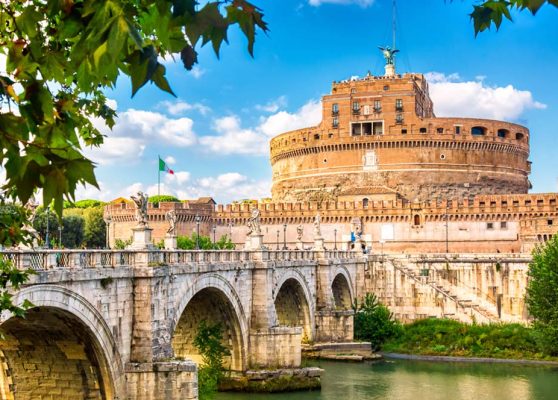Duration:
2h
Location:
Lungotevere Castello, 50
Available language:
English
Instant ticket delivery:
Yes
Maximum number of people:
20
Ticket on smartphone:
Available

Skip the line and delve into one of Rome’s most emblematic structures with a fast-track ticket to Castel Sant’Angelo. A professional guide will lead you through this grandiose mausoleum-turned-fortress, offering insight into its many corridors, chambers, and stunning rooftop views.
With a duration of around two hours, this tour balances informative guidance with ample time to absorb the beauty of this historical monument, allowing you to see some of the most striking panoramas of Rome from the rooftop and learn about its multifaceted past.
With fast-track access, visitors can bypass the typical waiting times and make the most of their day in Rome. The tour is led by a professional guide who will share intricate details and stories associated with Castel Sant’Angelo. Visitors receive headsets to ensure they can hear the guide even in busier areas.
Throughout this guided journey, you’ll explore a range of rooms that illustrate Castel Sant’Angelo’s transformation across centuries—from a mausoleum and papal fortress to a museum showcasing significant Roman and medieval art.
The rooftop view provides a memorable vantage point over Rome and the Tiber River, making this an ideal experience for those eager to see the city from a unique perspective. This tour is perfect for history enthusiasts and curious travelers who want to get a deeper understanding of this iconic Roman landmark in a more efficient manner.
This fast-track tour offers a blend of convenience and insight, designed to maximize the visitor’s experience within a limited timeframe. Castel Sant’Angelo, though popular, remains less crowded than other Roman attractions, making this tour a perfect choice for those who wish to enjoy a quieter, more contemplative visit. Guided by an experienced local, visitors can gain deeper understanding of its history and enjoy structured access to its most captivating areas.
Compared to other tours, this option is suitable for those who prefer a focused experience that is both rich in information and time-efficient. With fast-track access, travelers can quickly begin their exploration of this monumental structure without delay, ensuring a smooth experience. Whether you are visiting Rome for the first time or are a returning visitor, Castel Sant’Angelo offers an immersive, educational, and scenic experience that is both unique and memorable.
Located in Rome along the banks of the Tiber River, Castel Sant’Angelo stands as a testament to the city’s complex history, merging ancient Roman and medieval elements within its towering architecture.
The Castel Sant’Angelo’s structure is an impressive blend of different architectural styles accumulated over centuries. Originally built as a mausoleum for Emperor Hadrian, it later served as a fortress for the popes and even a prison. With the help of a guide, visitors can explore the various design aspects that reflect its unique evolution, including the cylindrical tower, the stone ramparts, and intricate murals adorning its interiors.
A walk through these spaces reveals a cohesive narrative of architectural ingenuity and historical functionality, showcasing Roman construction techniques alongside medieval defensive adaptations.
Castel Sant’Angelo’s interior boasts several notable rooms that shed light on its diverse past. Visitors will encounter the Hall of the Treasury, the chamber where valuable artifacts were once safeguarded. The Papal Apartment, adorned with Renaissance frescoes and period decorations, gives a glimpse into the lives of former papal occupants.
The Armory provides an impressive display of historic weaponry, while the prison cells echo with stories of the individuals once detained within its walls. Each chamber contributes to the narrative of Castel Sant’Angelo, providing a tangible connection to the complex history it embodies.
A highlight of the visit to Castel Sant’Angelo is the breathtaking view from its rooftop terrace. Overlooking the winding Tiber and stretching to include some of Rome’s most famed landmarks, the terrace offers an unforgettable perspective of the city.
Tour participants can take their time to capture photos, soak in the scenery, and experience the grandeur of Rome from above. The panoramic sight makes Castel Sant’Angelo a must-visit for those who wish to see the Eternal City from a unique and elevated viewpoint.
The starting point is just outside Castel Sant’Angelo’s main entrance, where guests can spot the guide holding a clear sign for easy identification. After exchanging smartphone vouchers for paper tickets, participants enter the site without waiting, thanks to the fast-track access. The guide will ensure all members of the group are ready before beginning the tour.
Darlene
Oct 7, 2024
The guide, we can’t remember her name, but she was absolutely the best guide we’ve ever had in all the years of traveling in Europe! Kudos to her and thank you for providing us with such a wonderful guide
Frank
Aug 11, 2024
A great sight to see that’s not nearly as crowded as the more famous attractions and offers a stunning view of the city
Lisa
May 14, 2024
We absolutely loved this tour! Silvia our tour guide was fantastic! She was very thorough and did not rush the tour. She was excited and enthusiastic which made us really into it. The history was amazing and I highly recommend doing this tour! I would do it again!
Eugene
May 5, 2024
Guide was very knowledgeable and entertaining. Was a tremendous experience.
Kelly
May 23, 2024
It was an organized tour. Meeting point was easy enough to find. The audio sets were decent quality to hear the guide. The guide was full of information to provide to the group. The group size was manageable. Unfortunately, I did not find Castel Sant’Angelo interesting, nor the information about it all that interesting. It was honestly quite boring to me comparative to other castles, prisons, churches, etc. that I have seen in other countries throughout Europe.
Similar guided tours